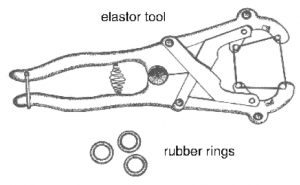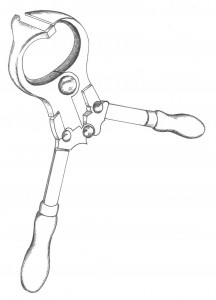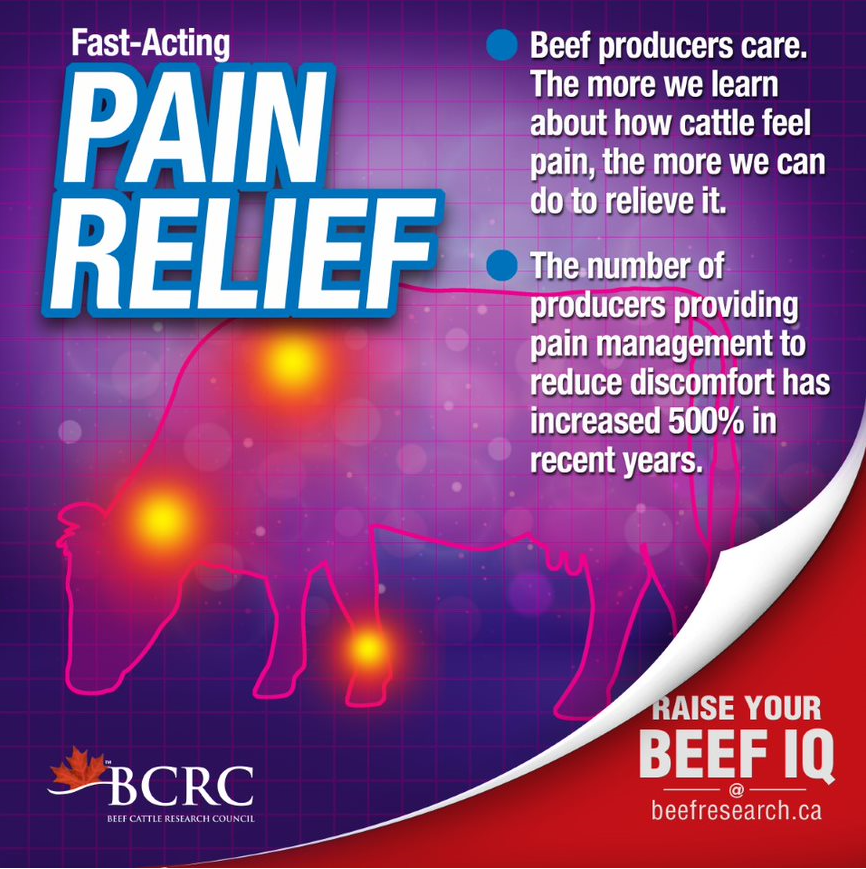Castration in Beef Cattle
Castration is the removal or inactivation of the testicles of a male animal. Castration is a common management tool in the beef cattle sector for many reasons, including to:
- Stop the production of male hormones
- Prevent unplanned mating
- Decrease aggression to enhance on-farm safety for handlers and animals
- Obtain price premiums and/or avoid price discounts from feedlots and meat packers
- Produce meat with a consistent quality acceptable to consumers (i.e. higher grade, better marbling)
- Decrease costs of managing bulls (i.e. larger, stronger facilities)
| Key Points |
|---|
| Perform castration when the animal is as young as possible, ideally soon after birth. |
| Pain mitigation must be used when castrating bulls older than six months of age as indicated in the Code of Practice for the Care and Handling of Beef Cattle (2013). |
| Castration must be performed by an experienced person using proper, clean, well-maintained equipment and accepted techniques. |
| Avoid castration during weaning or other stressful events. |
| Castration can be accomplished using surgery (i.e. “knife-cut”), or by restricting bloodflow to the testes by using a banding tool called an elastrator. Although less common, a specialized clamp called a Burdizzo may also be used to crush the testicular cord and associated tissues. |
| Castration is a common practice, however there may be risks, including pain, swelling, bleeding, and infection. Reduce risks by using proper techniques, clean tools, adhering to a proper vaccination protocol, and castrating animals when they are young. |
| Pain medication, such as anesthetics and analgesics, is effective at reducing pain and improving welfare. A number of different pain-control products are commercially available. Producers are using pain medication for castration, in consultation with their veterinarians, more than ever before. |
Timing
Castrate calves at the youngest age practically possible, and prior to weaning. When possible, avoid castrating during fly and insect season.
As an animal gets older, the health and welfare risks of castration increase. The area of affected tissue becomes larger, and the impact on animal performance increases. Castrating bull calves soon after birth improves animal welfare, better health and feedlot gains, and enhanced marbling and tenderness compared to animals castrated at or post-weaning.
The Code of Practice for the Care and Handling of Beef Cattle requires that castration be performed by an experienced person using proper, clean, well-maintained equipment and accepted techniques. Pain control is required when castrating bulls over six months of age.
Castration, particularly using surgical methods, is commonly performed when calves are 3-6 weeks of age, often at the same time as other common procedures such as vaccination and branding. Recent research shows that acute pain increases when calves are branded and castrated simultaneously. Pain medication was effective at reducing signs of acute pain. Chronic pain, swelling, or animal performance did not differ between steers that were castrated only or castrated and branded.
According to producer surveys, most operations across Canada castrate calves prior to three months of age, including Ontario at 53%, Atlantic Canada at 69% and western Canada, at 94%.
Methods
Common physical methods of castration include surgical removal of the testes, or stopping the bloodflow to the testes by applying an elastrator band or using a Burdizzo tool. Research has demonstrated that banding at 2 months caused less acute (i.e. immediate pain) than surgical castration, however banding at 4 months caused more chronic pain.
Immunocastration uses strategic injection of hormone-suppressants and requires repeated injections to remain effective. There is no commercial product currently available in Canada, therefore this technique is not in use.
Surgical castration
Surgical castration involves making an incision into the scrotum followed by the physical extraction of both testes. Physical removal is also used when necessary at the feedlot, where intact males are typically 6-12 months of age.
Elastrator banding
“Belly nuts” can occur when one or both testicles are mistakenly pushed upward into the body cavity and the ring is placed below them. If this happens at banding, cut the band off and try again. Failing to fix these mistakes in the young calf means that the feedlot will need to conduct a very painful, invasive, costly, unpleasant surgery in an older animal.
Elastrator banding involves using a specialized tool to place a purpose-designed rubber ring or latex band around the scrotum, between the testicles and the abdomen. This disrupts the testicular blood supply, causing the testis and the scrotum to slough off 3-6 weeks later. The rubber ring technique is typically performed on at birth or within a few days of birth. This method is relatively rapid in young animals, and has a low failure rate (5%) however incorrect application, particularly in young calves, can result in “belly nuts” which are costly and painful to remedy.
Older animals may be banded using latex bands, however they may have an increased risk of tetanus. Producers should consult their veterinarians about providing additional vaccination protection.
There is no clear evidence that either surgical or banding castration produce better animal performance.
Figure 1. Elastrator tool and rubber rings used for baby calves

Burdizzo
A Burdizzo is a specially designed clamp that is used to physically crush the testicular cord through the scrotal skin. This trauma disrupts the testicular blood supply, causing the testes to die. With this technique, the scrotum remains intact, the testes eventually shrink down, and the animal becomes sterile. This technique is becoming less common in the cattle industry. Compared to surgical castration, this method takes longer and has a higher failure rate (up to 35%), particularly with old or poorly maintained equipment.
Figure 2. Burdizzo clamp tool

Reducing Risks
Although castration is a common and effective production practice, complications may arise from the procedure, including infection, swelling, bleeding, discomfort, and pain. These complications are minimized when castration is done at the youngest age possible; when proper, clean techniques and well maintained equipment are used; and when animals are adequately vaccinated.
Castration improves carcass quality however it decreases daily gains and feed conversion ratios compared to intact bulls. The development and use of growth implants have been able to offset these disadvantages to produce steers that grow rapidly and efficiently without the risks associated with feeding bulls.
Managing Pain
Managing pain in cattle has become a public concern and a producer priority, particularly with the development and availability of pain medication such as non-steroidal anti-inflammatory drugs (NSAIDs).
All methods of castration are painful. Surgical castration causes more intense pain that lasts for a few days, while banding castration causes a less intense but chronic pain that lasts for over a month. Producers should consult with their veterinarians on the best methods to manage pain during and after castration.

The following webinar discusses the difference between using local anesthetic or NSAIDs for castration pain control (42:22), requirements under the Code of Practice for Beef Cattle (44:00), different castration methods (45:11), and practical research results (46:12).
Canadian researchers are currently studying castration pain and its mitigation. Within the industry, castration at birth is currently viewed as the most humane practice, based on existing research and clear evidence that the surgery is less invasive in smaller animals.
An anesthetic (e.g lidocaine) is a drug that temporarily eliminates all feeling. Local anesthetics cause numbness; general anesthetic cause unconsciousness. Anesthetics need to be injected 5 to 20 minutes or so before the operation, and can provide several hours of pain relief.
An analgesic or NSAID (i.e. metacam) temporarily eliminates pain, but not normal sensation. Analgesics are longer-acting than anesthetics, and may provide some pain relief for up to a day after castration. NSAIDs control swelling and pain for a variety of different conditions although one-time injection products do not last long enough to eliminate all of the symptoms associated with band castration. Studies with experimental in-feed products (e.g. oral meloxicam or acetylsalicylic acid) have shown some potential for banded feedlot cattle, but do not appear to be practical for nursing calves on pasture.
A number of pain control products have been approved for use in beef cattle and can be found in this table.
According to surveys, producers are mitigating pain during castration. Ten percent of producers in Atlantic Canada and 26% of producers in Ontario indicated they always used pain control or did so depending on the method and age of animal. In western Canada in 2017, 28% of producer respondents always used pain control or did so depending on the age and method. This was a marked increase from 4% of producers polled in the region in 2014 who managed pain during castration.
- References
-
- Anderson, D.E., Muir, W.W. (2005) Pain management in ruminants. Vet Clin Food Anim; Vol 21:19-31.
- Coetzee, J.F., Gehring, R., Tarus-Sanf, J., Anderson, D.E. (2010) Effect of sub-anesthetic xylazine and ketamine (‘ketamine stun’) administered to calves immediately prior to castration. Veterinary Anaesthesia and Analgesia; Vol 37:566-578.
- Coetzee, J.F., Edwards, L.N., Mosher, R.A., Bello, N.M., O’Connor, A.M., Wang, B., KuKanich, B., Blasi, D.A. (2012) Effect of oral meloxicam on health and performance of beef steers relative to bulls castrated on arrival at the feedlot. Journal of Animal Science Vol 90:1026-1039.
- Field, R.A. (1971) Effect of Castration on Meat Quality and Quantity. Journal of Animal Science Vol 32(5), 849-858.
- George, L.W. In: Recent Advances in Anesthetic Management of Large Domestic Animals, E.P. Steffey (Ed.) Publisher: International Veterinary Information Service (www.ivis.org), Ithaca, New York, USA. Pain Control in Food Animals (9-Oct-2003)
- Gonzalez, L.A., Schwartzkopf-Genswein, K.S., Caulkett, N.A., Janzen, E., McAllister, T.A., Fierheller, E, Schaefer, A.L., Haley, D.B., Stookey, J.M., Hendrick, S. (2010) Pain mitigation after band castration of beef calves and its effects on performance, behavior, Escherichia coli, and salivary cortisol. Journal of Animal Science, Vol 88(2):802-810.
- Marti, S., Melendez, D.M., Pajor, E.A., Moya, D., Gellatly, D., Janzen, E.D., Schwartzkopf-Genswein, K.S. (2018). Effect of a single dose of subcutaneous meloxicam before knife castration alone or combined with hot-iron branding on scrotal healing, inflammatory response, and behaviour in 2-mo-old beef calves over 42 d post procedure. Canadian Journal of Animal Science, Vol 99(1): 179-190.
- Melendez, D.M., Marti, S., Pajor, E.A., Moya, D., Gellatly, D., Janzen, E.D., Schwartzkopf-Genswein, K.S. (2018). Effect of a single dose of meloxicam prior to band or knife castration in 1-wk-old beef calves: I. Acute pain. Journal of Animal Science, Vol 96 (4): 1268-1280.
Feedback
Feedback and questions on the content of this page are welcome. Please e-mail us.
Acknowledgements
Thanks to Dr. Eugene Janzen for contributing his time to reviewing this content.
Expert Review
This content was last reviewed September 2019.
Ce contenu a été révisé pour la dernière fois en Octobre 2023.